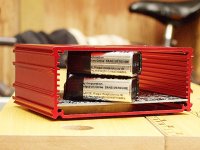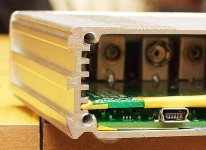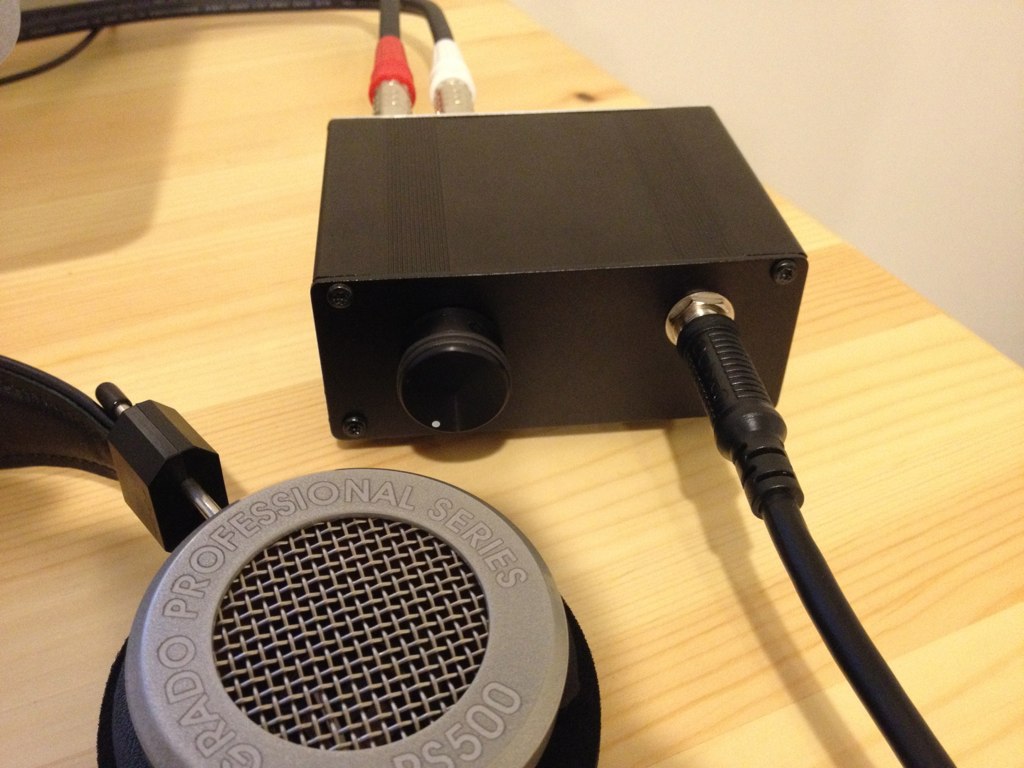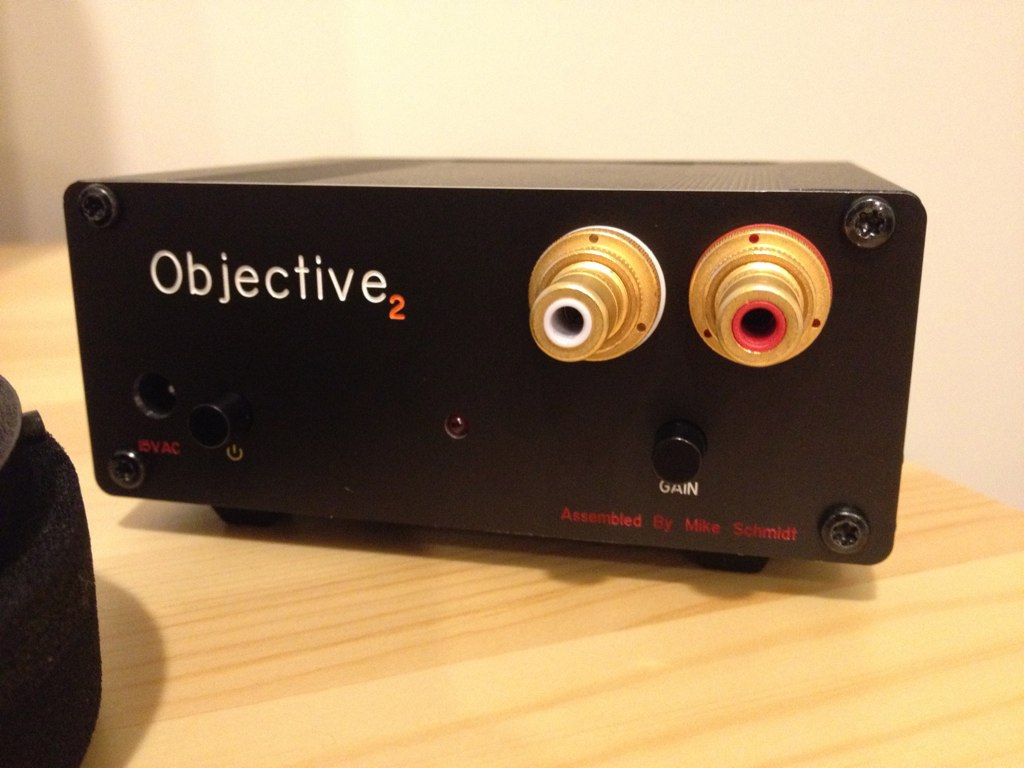I've been shock-proofing my O2. There's no give so if it dropped on to something hard then there is a real risk of damage, such as fracture, perhaps, of solder.
I filed down the edges and put electrical tape as the soft zone on each of the four edges. I've only put a little on front and back as there is limited usable space. Filing down also means that were one to do the double battery arrangement, as in the previous photo, then there will be space for a little anti-shock foam (or whatever material) on the top the the highest battery.
The ODAC also has a piece of cardboard on top of the coil filter as well as a large piece keeping it in place at the rear. I'm considering filing down some of the ODAC pcb as the USB jack area is too tight for anti-shock, and lead-free solder is even more delicate so I think it's a necessary adjustment.
(marvellously, I dropped the O2 on to stone just after doing this. The ODAC was already installed, but the force was lateral and merely moved the ODAC out of alignment).
I filed down the edges and put electrical tape as the soft zone on each of the four edges. I've only put a little on front and back as there is limited usable space. Filing down also means that were one to do the double battery arrangement, as in the previous photo, then there will be space for a little anti-shock foam (or whatever material) on the top the the highest battery.
The ODAC also has a piece of cardboard on top of the coil filter as well as a large piece keeping it in place at the rear. I'm considering filing down some of the ODAC pcb as the USB jack area is too tight for anti-shock, and lead-free solder is even more delicate so I think it's a necessary adjustment.
(marvellously, I dropped the O2 on to stone just after doing this. The ODAC was already installed, but the force was lateral and merely moved the ODAC out of alignment).
Attachments
Last edited:
Can someone remind me how many cells these batteries need. I remember that some aren't suitable due to too few or too many cells.
here the excerpt from NwAvGuy's Blog:
"TYPE OF BATTERIES - The O2 is intended to use Ni-MH “9 volt” (usually 8.4 volt rated) batteries. The Tenergy 8.4V batteries in the parts list are about 9.5 volts when fully charged and have 7 cells inside. There are also 6 cell (7.2 volt) and 8 cell (9.6 volt) batteries. While the 6 and 8 cell versions will sort of work, they’re not recommended. Alternately, you can also use disposable 9 volt alkaline batteries as you would in a Cmoy. Do not connect the AC power with Alkaline batteries installed (they’re not rechargeable)."
Oh, Digikey also has the nicer knobs if you're placing an order with them. ML-50-4-6MM Kilo International | 226-4003-ND | DigiKey
O2 Desktop Version
Built into a Black Cube clone case.
The O2 board was piggy-backed on the Black Cube clone pcb, which is exactly the same width. The battery-related parts, gain switch, input/output sockets, LED, and volume control were left off the O2 board and wired up as required.
The original O2 volume control was replaced by a new Alps 10KAx2, and the output socket by two new gold-plated Neutrik ones. The O2 on/off switch was left in place and is operated via an extender through a new hole drilled in the front panel just above the LED.
There's an input switch at the back to select between the ODAC and one pair of rear phono sockets, the other pair of phono sockets being connected to the left-hand headphone socket to act as a switched output, as in the original (?) clone.
AC comes in from a socket at the rear via a short length of USB cable, with the cable screen grounded at the front end.
Built into a Black Cube clone case.
An externally hosted image should be here but it was not working when we last tested it.
The O2 board was piggy-backed on the Black Cube clone pcb, which is exactly the same width. The battery-related parts, gain switch, input/output sockets, LED, and volume control were left off the O2 board and wired up as required.
The original O2 volume control was replaced by a new Alps 10KAx2, and the output socket by two new gold-plated Neutrik ones. The O2 on/off switch was left in place and is operated via an extender through a new hole drilled in the front panel just above the LED.
There's an input switch at the back to select between the ODAC and one pair of rear phono sockets, the other pair of phono sockets being connected to the left-hand headphone socket to act as a switched output, as in the original (?) clone.
AC comes in from a socket at the rear via a short length of USB cable, with the cable screen grounded at the front end.
An externally hosted image should be here but it was not working when we last tested it.
Oh, Digikey also has the nicer knobs if you're placing an order with them. ML-50-4-6MM Kilo International | 226-4003-ND | DigiKey
They definitely do have the better knobs. It still doesn't solve my problem because Digikey doesnt have Lelon capacitors...that's the part that has the longest backorder.
I would hate to place an order in 3 different places, shipping can get expensive for one part or two.
I would hate to place an order in 3 different places, shipping can get expensive for one part or two.
Likewise. There are plenty of alternatives listed in the BOM: Nichicon UVR1V471MPD1, Epcos B41827A7477M000, Panasonic, EEU-FR1V471B, ECA-1VM471B
Else you could get the whole lot from me
Stefan
For my first O2 I got two 250mAh Tenergy batteries from ebay seller vt12340 in the US. They've been in use for 6 months now without problems.
The price for two delivered to the UK is currently £11.52 - I've no affiliation with the seller, but was satisfied with the service. No import duty/VAT to worry about for that value.
The price for two delivered to the UK is currently £11.52 - I've no affiliation with the seller, but was satisfied with the service. No import duty/VAT to worry about for that value.
Built into a Black Cube clone case.
The O2 board was piggy-backed on the Black Cube clone pcb,
What is the black cube, and in what way is the O2 working with it? Or are they just sharing case space?
What is the black cube, and in what way is the O2 working with it? Or are they just sharing case space?
Sorry, shouldn't have assumed it was widely known.
This is the original
The one I had was an inexpensive Chinese clone. It produced enough heat to cook an egg, so I soon stopped using it.
My first O2 6 months ago was a revelation in terms of sound quality, but I wanted to have a more substantial case to go on my desk and a bit more connection flexibility (as NwAvGuy is planning with the ODA). When I noticed the O2 and the Black Cube (BC) pcbs had identical widths, I thought I'd try to make use of the case I already had.
The BC pcb uses a bigger Alps potentiometer and Neutrik 1/4" headphone sockets, so it was convenient to make use of the solder pads to mount the new ones I got for the O2 and have them line up with the holes in the front panel. After stripping all the components from the BC pcb I drilled holes for some mounting pillars for the O2 board and to route the wiring to the headphone sockets, potentiometer, LED, etc.
I was running my first O2 at 1x gain, so was able to completely leave out the gain switch and associated resistors.
The new Alps potentiometer has a really nice feel to it, and is logarithmic, so operates identically to the original O2 one in electrical terms.
Sound quality seems at least as good as my first O2, with the usual completely silent background. But it looks nicer to me
Sorry, shouldn't have assumed it was widely known.
The one I had was an inexpensive Chinese clone...etc
Great, thanks for that.
can you link the clone ?
-joe
can you link the clone ?
-joe
There's more than one, but mine was this one
I got it quite a while back, so I think some of the cosmetic aspects have changed.
For my first O2 I got two 250mAh Tenergy batteries from ebay seller vt12340 in the US. They've been in use for 6 months now without problems.
The price for two delivered to the UK is currently £11.52 - I've no affiliation with the seller, but was satisfied with the service. No import duty/VAT to worry about for that value.
Thanks. I've given them a try too. You can't have too many PP3s!
I wish someone would do that (SMD version)! The O2's physical size could probably shrink 30% or more if both sides of the board and SMD parts were used, and/or more stuff could be put on. You might want to shoot RocketScientist a PM or email on his website. Maybe he would have some interest in the project. Sounds like he is pretty slammed with the day job right now, but if someone else did a layout and board stuffing maybe he would be willing to look it over. By his licensing terms on the O2 design you could only use the (modified) design/board for yourself - the DIYers here couldn't do a group buy, etc from the way I read it. Maybe he would be willing to allow a SMD version of the PCB to be made available to the DIY community once the art is done and if he were able to find time to verify the results on his equipment.
You also might want to consider starting a separate "SMD O2" thread too, given the length of this one. I'll bet there are a lot of folks on the forum here with SMD experience that might want to chip in comments and ideas on something like that.
Just a thought!
I'd also be interested in combining the ODAC+O2 on one PCB, giving me some more experience in mixed signal design. I'm not sure when I could start playing around with this idea since I only have access to the Altium design software at work, and I'd prefer using that for the features as opposed to other freeware packages out there(unless there's comparable ones someone can recommend).
Where is NWavGuy lately?
Question for the designer; he mentioned PCB layout is critical to the DAC performance and especially noise.
BTW, What happened to our illustrious RocketScientist? His blog posts were reliably every month since way back, but he has not posted since May. Is he well?
I'd also be interested in combining the ODAC+O2 on one PCB, giving me some more experience in mixed signal design.....
Question for the designer; he mentioned PCB layout is critical to the DAC performance and especially noise.
BTW, What happened to our illustrious RocketScientist? His blog posts were reliably every month since way back, but he has not posted since May. Is he well?
- Home
- Amplifiers
- Headphone Systems
- The Objective2 (O2) Headphone Amp DIY Project



